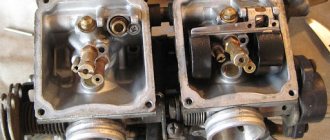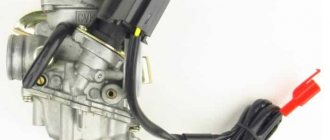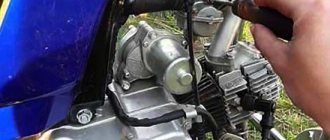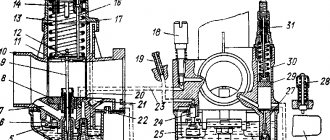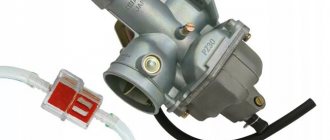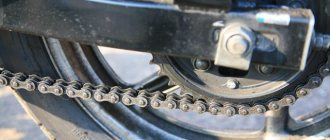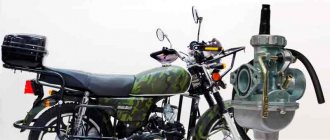Carburetor adjustment is an important skill for a motorcyclist to tune a motorcycle engine for optimal fuel consumption. Achieve maximum power while maintaining the excellent condition of the power unit for many years of operation.
The two-cylinder boxer engine has a carburetor for each cylinder, which increases the difficulty of tuning, especially the synchronization of the cylinders. When setting up each device, you must strictly follow the sequence of actions described in the instructions; this is the only way to achieve the best result.
First you need to understand the principle of the device for preparing the fuel mixture. Find out what each part consists of, what each part is needed for, and what role it plays. With the help of which the device parameters are changed. What will happen if you turn the adjustment screws.
Preparing for adjustment
Adjusting the K-37A carburetor of the Ural motorcycle has three stages of adjustment: 1. idle; 2. at medium speeds; 3. uniform operation of both carburetors.
Before starting the setup, it is advisable to remove the carburetors and disassemble them to check for serviceability. To do this, check the fuel level, if necessary, change it and bring it to normal. Clean all jets and fuel and air passages. Check the control drive of each device. When installing, pay attention to the tightness of all connections.
Before starting, pay attention to the condition of the piston and measure the compression ratio in the cylinder. The cylinder-cylinder head connection is assembled without air leaks. If you need to replace the gasket.
Pay attention to the ignition. Inspect the spark plugs and spark quality. In case of malfunction, install new spark plugs.
Carburetor adjustment should be carried out on a warm engine, and the carburetors should first be adjusted individually.
Inappropriate installation option
What carburetors are suitable and what is better to install? We will have to disappoint those who plan to use available models from Oka or Zhiguli during the conversion. All car modifications are out of play in this case. There are several reasons:
- The vacuum in the intake tract of a motorcycle differs from the parameters typical for car engines. Because of this, correct adjustment of the carburetor on a motorcycle becomes almost impossible.
- The selection is carried out not simply by working volume, but by the number of aspirations per unit of time. Aspiration can be roughly calculated by multiplying the engine displacement by the maximum speed.
- Car models pose a danger if the motorcycle falls because fuel can splash out and ignite.
Automobile carburetors are not suitable for conversion!
So the idea of using parts from Oka or other automotive equipment will have to be abandoned.
Idle speed adjustment
The idle speed is adjusted in the following order: 1. Close the throttle completely. 2. Unlock the stop screw 19 (see figure) and screw it into a position so that the engine runs at slightly higher speeds. 3. Set the ignition timing shifter to late ignition. 4. Turn mixture quality screw 18 all the way in. 5. Turn screw 19 out 1-1.5 turns, the engine speed will decrease. 6. Listening to the operation, gradually turn out the mixture quality screw until the engine evenly develops a higher number of revolutions. 7. By unscrewing the thrust screw, reduce the speed to the minimum stable speed. 8. Lock both screws.
It is recommended to adjust the carburetors of the Ural motorcycle to a slightly enriched mixture. With such a mixture, starting becomes easier and low speeds (idle) become stable.
Creating the Intake Manifold
Having chosen which carburetor to install, we proceed to the next step - creating an intake.
First, we remove everything unnecessary - old carbs, filter, freeing up the area. Now you need to make three mounting plates. To do this you need to use metal, no thinner than 5 mm. The plate will act as a tip that is fixed to the cylinder (similar to the plates on the exhaust elbows). On the cylinder side, it must retain the mounting points and have an internal diameter corresponding to the diameter of the inlet port. You can use the old plate on the carburetor side by cutting off part of the seat from the original part (if the design allows). Parts can be ordered from a turner or made from CNC equipment. The last resort is to do everything yourself, using a drill, a file and a lot of patience. Now we need to put everything out. The plates are screwed into their seats, and the carburetor is rigidly fixed in its future location. Important! When aligning the carburetor, please note that it must be raised relative to the gearbox by at least a few centimeters. The next stage is the selection of pipes and welding machine. It is best to use stainless steel pipes, perform rough fasteners “on site” using manual electrode or semi-automatic welding, and finally weld the parts using argon or gas welding
It is best to use stainless steel pipes, perform rough fasteners “on site” using manual electrode or semi-automatic welding, and finally weld the parts using argon or gas welding
The next stage is the selection of pipes and welding machine. It is best to use stainless steel pipes, perform rough “on-site” fasteners using manual electrode or semi-automatic welding, and finally weld the parts using argon or gas welding.
Such a high-quality finishing weld is needed to ensure that the inside of the manifold is in a perfectly smooth condition, otherwise swirls or irregularities may appear that prevent normal intake. If there is only rough welding, then it is worth welding the manifold in stages, polishing the welded joint each time
Note! Due to the peculiarities of the arrangement of the cylinders in a boxer engine, the manifold created in this way cannot be of equal length, so try to make the intake pipes as equal as possible. On the other hand, if you install the carburetor not symmetrically, relative to other parts, the problem can be avoided. Solving the problem with the air filter
As you already understood, the old air filter is no longer suitable for installation. Some people get sophisticated by installing one carburetor behind the filter, making an incredibly long intake. This option has a lot of disadvantages, but the most obvious is the inability of the system to adequately respond to gas and they do not work at low temperatures. The way out of this situation is a new filter. You can make it yourself; many people approach the issue creatively, placing the filter inside a flask, leather bag, first aid kit, etc. Such a new element looks quite original and can fit well into the overall style of the motorcycle. On the other hand, the market is simply overflowing with short filters of zero resistance, which will ideally fit in a new place.
The last stage is starting the Ural engine and setting it up. Some imported carburetor models do not have an enricher, which must be taken into account when purchasing. Otherwise, the idea is simple: when the engine starts, we do a test drive, with maximum spin in low gears and try to reach speeds of more than 100 km/h. If the engine does not pull, perhaps a more efficient jet will solve the problem; you also need to work some magic with the idle speed setting.
Note! This entire system has one significant drawback - problems with operation at low temperatures. In the cold, condensation forms in a long manifold, which inevitably leads to deterioration in engine performance.
You can try to isolate the inlet with rubber pads or other insulating materials. Plus, you shouldn’t do test runs and adjustments in the cold season.
Conclusion
Now you know how to install one carburetor on a Dnepr or Ural motorcycle. Before you start work, weigh the pros and cons, correctly assess your abilities, because if you don’t have a lot of money to entrust this work to workshops, you will have to use the skills of a welder, designer, mechanic and others. On the other hand, by correctly completing all the described points, you will lighten the burden of owning Soviet equipment and will be able to ride a motorcycle without any problems, even in everyday use.
Adjustment at medium speed
Setting up the K-37A device of the Ural motorcycle at medium speeds is done as follows.
If, when the throttle valve is opened sharply, “sneezing” is observed in the carburetors and the engine stalls, then the mixture must be enriched by shortening the adjusting needle 12 by one or two holes.
If the “sneezing” stops and the engine revs well, then the adjustment has been made correctly. It is recommended to ride a few kilometers after this and make sure that the motorcycle pulls well.
Adjustment of carburetors K-301, K-65, K-68.
The easiest way to adjust. In fact, everything is very simple!
Hi Evgeniy. How do you feel about the so-called spitters?
Evgeny everyone knows this bullshit, but those who don’t know will find it. But detailed settings here are much more difficult. I'm talking about changing the diameter of the jets, raising and lowering the needle, changing the float level. How to play with them is also clear, but how to determine what exactly this operation needs to be done? After all, the engine should work most of the time at medium speeds, and not at idle. I would like to know more about these features. And tune the engine so that it runs smoothly and can tear
Hi Zhen, why doesn’t my Ural work on one pot? The left one works well, but the right one sneezes but works. The left one works, the right one cannot.
Hi Zhen.Chyo did not add that the adjustment is carried out on a warm engine, and even when adjusting the carburetor on a car, for example, when adjusting the amount of mixture, the quality of the mixture is adjusted again, i.e. reduced the speed again, looking for a bump, increased it again, looking for a bump, i.e. For certain XX speeds you need to select the slide again or am I wrong?
Yesterday I adjusted it according to the same scheme. But the bike doesn't shake much at idle. I understand this is due to the difference in compression?
And if the ignition is electronic, then how to synchronize it, you can’t remove the cap there?
Evgeniy, do you need to unscrew the spark plug from the non-adjustable cylinder?
And you didn’t add that the carb is adjusted last after checking the CPG and setting the ignition
And where is the repair of Jupiter?
I have X-1 for setting up carboses, everything is simple, screw it in, set it up))
Tell us in more detail about the adjustment to 302. Which screws are responsible for what?
Hello Zhenek! listen, I can’t make the hill correctly on the K-301A, the speed increases and does not fall when I turn the quality screw, Ural m 72
and the candles are always black in soot
Zhenya, here’s a question: does it make sense to abandon the Soviet K301 in favor of the Taiwanese K68?
What can you say about inertial supercharging?
please make a video on how to properly adjust the valves
Evgeniy needs help. there is a problem with adjusting the carbs to 65t in the urals m 67-36. The right cylinder is difficult to adjust. It works intermittently at idle. The carb was removed, washed, and blown out, it didn't help. compression in both cylinders is 8 points. The piston and cylinders are new and the mileage with them is 1500 km. The ignition is set correctly. I suspect a defective carb. Russian-made carbs. The air was washed and purged.
Well, this is setting the mixture quality screw, and the synchronization is not entirely correct, you can’t take off the caps on electronic ignition, and setting the operating mode with a needle?) But what about the setting at full throttle opening with a jet?) And where about the level in the float chamber? Super! Beginners should have more questions than the answers given in the video), they won’t be driving at idle.
There is so little sensible information on the Internet, thanks for the video.
Evgeniy you are the best master I have met
it's clear that a man has a head
I've never synchronized them, but I'll have to try
Tell me, maybe you have experience installing a pz30 with an accelerator pump?
HELLO. Evgeniy, tell me_ - I bought new ones for 68. The baker's carbs can be adjusted normally, but the left pot shoots when the gas is released. If you tighten the quality screw completely or leave it 1 turn, it stops shooting when you re-gas it. I thought the ignition was on, I swapped the caps, it didn't help. the right cylinder works as it should. Could this be due to air leaks from the head to the knee? OR due to large valve clearances? heads after capital.
Timing adjustment
Adjusting the uniformity of operation of both carburetors is quite difficult, especially since the synchronism is maintained for a relatively short time. However, it must be achieved and constantly maintained. Non-synchronous operation will lead to rapid wear of the connecting rod bearings and, when driving, will cause overheating of one of the cylinders and increased carbon formation.
The adjustment procedure is as follows: 1. Place the motorcycle on a stand so that the rear wheel can rotate freely. 2. Start the engine and engage fourth gear. 3. Remove the high voltage wire from the spark plug of one of the cylinders. 4. Bring the engine speed to a number corresponding to a speed of 30 km/h on the speedometer, and listen carefully to the operation of the cylinder. 5. Turn off the cylinder from operation by removing the high voltage wire from it, and at the same time put the wire on the spark plug of the not working cylinder. 6. Listen carefully to the operation of the second cylinder. 7. Comparing the operation of the cylinders by ear or according to the speedometer readings, you need to achieve synchronous operation of the devices by raising or lowering the throttle valve using the cable stop 26 (see figure).
Since such adjustment takes a relatively long time, you must be very careful not to overheat the engine, especially a new one, in which, if overheated, the pistons in the cylinder can easily jam.
The best carburetors.
What are the best carburetors for the Ural 750cc with sidecar drive? I drive mostly in the forest, and in the mud, and sometimes I ride on the highway too.
Rename the topic, you are misleading people, do you want to buy the best carburetors, sell them as a gift. I won’t say anything on the topic; I haven’t driven a 750 Ural and don’t plan to.
I don't buy or sell while I'm interested.
if price-quality then k68t. not China.
Where can I find them?
All you can fart?
Never mind. If you don’t drive in winter, then monocarb from the car
If you don’t drive in winter, then get a monocarb from the car.
to 63u. if you find it. there the needle is bronze and longer than 65. Unlike the Kuikhins, you can climb deep into shit. nothing gets caught, and they are easy to clean.
Yes..expensive.
What kind of carburetors (from what motorcycle?)? __________________________________________________ “Please note that Republican credit cards are not in use here!”
Former alcohol, converted to gasoline. 34 diffuser. Without accelerators.. They were made for a cross-country stroller, but they were not useful.
And why are they better than the cheap K68 or the same vacuum seals from disassembly?
Judging by the stamp, Italian? For sale? How expensive? __________________________________________________ “Please note that Republican credit cards are not in use here!”
PMed me
The question implies an answer in the style: “Every sandpiper praises its own swamp..”) As in most similar topics.
I myself am puzzled by this topic now. There are dellorto 30, and keihin 32 and 68And and not I, and IKOVY, etc. I came to the conclusion that none of the above fits. But I still have volume 833.
For heavy use you need carbs: -not vacuum ones! -protected! -Easy to wash! -Easily disassembled! -reliable! -cheap! -have repair kits!
..I have some ideas..if I can, I’ll voice them.
Mikuni from a dog. Other options do not meet at least two of the proposed requirements, including k68. Protected - you had vacuum bsr36-89, which should work perfectly with normal jets. Chinese copies from sfmoto are relatively cheap.
Big ones. A maximum of 32-34mm diffuser is needed. And again, the priority is the gate.
Other options are expensive. Unless we put China. There are analogues of pwk series keihins. They also have needles and jets for every taste and color. The question is how long it takes. Originals are expensive. It's a double-edged sword.
For heavy use you need carbs: -not vacuum ones! -protected! -Easy to wash! -Easily disassembled! -reliable! -cheap! -have repair kits!
..I have some ideas..if I can, I’ll voice them.
1. vacuum ones are no worse than gate valves on off-road terrain 2. if by protected we mean from dirt and water, then they are protected no less than gate valves, and even more if used from ATVs. Also, if possible, use “lying” carbs so that you can place them much higher than the cylinder + they will not interfere with your legs. However, if you drown a motorcycle up to the gas tank, then the engine needs more protection, but why drown it if you can usually go around it? 3.inside? To avoid getting clogged when driving off-road, just move the ventilation hoses higher and that’s it. 4. 4 screws on the bottom, 4 on top and the carb is in full view. 5. The Japanese don't break. 6. one thousand to one and a half rubles apiece for disassembly. 7. See previous paragraph.
I have K68u carbs from Pekarovsk, with installed GTZh from Izha Jupiter 235. I drove about 5 thousand on them in a wheelchair. Then for some reason I installed the K68T with the original 220 jets. I bought it while drunk. It got duller at the bottom. I can sell k68U with Iupaka fluids. I installed VasyaPZ) which already creates a certain aura of hihyha. Anyway, my 750 pikhlo exploded. I’ll definitely have a 650cc for about 2 years, I’m tired of spending money on this Ural
Preparing to adjust carburetors
Before you start adjusting carburetors, make sure that the valve clearances are set correctly and that the ignition is not disrupted and is working correctly.
It is recommended to read the information on setting up valves in the Urals. And in this article you can find out how to set up the Ural ignition.
The carburetors should not be worn out or different, otherwise nothing will work out for you, and tuning will be impossible. The carburetors themselves must be clean both outside and inside without plaque, traces of rust and other deposits, each jet must be blown with compressed air, the shut-off needle is in working order, and the floats are sealed . Check the condition of the rubber pipes; cracks are unacceptable. Is the air filter clean?
It is important to know: one of the big problems is the leaky installation of carburetors and the connection of rubber pipes with the air filter. If there is an air leak somewhere, this can lead to engine overheating and dust getting into the cylinders.
Carburetor removal process
On a motorcycle, removing the carburetor is the easiest way. First, the gas tank is removed (don’t forget to close the tap), then two nuts are unscrewed from both sides of the carburetor, which connect the carburetor to the cylinder through a pipe. After which the carburetor is removed, the fuel supply hose is first disconnected.
It is a little more difficult to remove the carburetor on a car, but carburetor engines are quite repairable and it is not difficult to gain access to any unit. To remove the carburetor, it is advisable to remove the air filter housing. The filter is easy to remove, but be careful not to let the nuts get into the carburetor. In the best case, the nut will be held back by the throttle valve, in the worst case, it will fall into the engine cylinder, creating the need to remove the cylinder head. After removing the air filter housing, you can remove the carburetor by unscrewing the four nuts. Before doing this, you must disconnect the accelerator and choke cables and all electrical wires from the carburetor.
The first stage of adjusting carburetors on a Ural motorcycle
- Using the “quantity” screw (pictured No. 1), we lower the speed to the minimum stable.
- Using the “quality” screw (pictured No. 2), we increase the speed until it stops growing.
Repeat points 1,2 – 2-3 times. We do the same on the other cylinder. We achieve the same operation of the cylinders individually by ear, ideally by the tachometer.
3. Connect both spark plug wires and synchronously turn the mixture quantity screws with both hands until the minimum idle speed is obtained. The engine should run smoothly and without jerking. The first part of the adjustment affects the stability of the launch of the Ural motorcycle, the correct operation of the carburetors at the initial opening of the throttle valves.
It is worth noting that: if you have an outdated model of carburetors, such as the K-65, the “quantity” screw No. 1 is located on top, on the carburetor cover.
Messages [19]
1↑ Topic from Student 08/14/2013 15:05:15
- Student
- Assistant
- Inactive
- Name: Ivan
- From: Engels
- Registered: 11-04-2013
- Messages: 267
- Reputation: 3
- Motorcycle: Dnepr MT 10, Dnepr MT 11
Topic: How to synchronize carbs (the easiest way)
I was surfing the Internet and found this article, tried it myself, everything works, it’s super simple. I think the easiest way is for beginners and those who don’t have a speedometer
After you have adjusted the idle speed, turn off the engine. Next you will need a second person, an assistant. Remove the air filter pipe from the carburetors (K-65). Using your left index finger, touch the throttle valve of the left carburetor. At the same time, touch the throttle valve of the right carburetor with the index finger of your right hand. At this point, the second person should pull the throttle very slowly. You will feel which throttle valve (left or right carburetor) will rise first. Achieve simultaneous lifting of the throttle valves by rotating the fittings on the carburetor covers. That's all the adjustment is. This method can be used on any carburetors.
Second phase
Now let's move on to the main second stage of carburetor adjustment in the Urals. Place the Ural motorcycle on the center stand, or in any way convenient for you, hang the rear of the motorcycle so that the rear wheel is in free rotation.
Start the motorcycle again and remove the spark plug wire from the right cylinder. Engage 4th gear, add a little gas, and the speedometer should show 55 km/h. Lock the throttle in any convenient way in this position (there is a small screw in the throttle for this). Then put the right spark plug wire back and remove the left one. Using the screws on the carburetor covers, we adjust the length of the cables so that when working on each cylinder, the speed on the speedometer does not change. This will ensure synchronized operation of the throttle valves during transient operating conditions.
Carburetor cleaning
Cleaning the carburetor occurs after removing it and is the first recommended procedure if gasoline is leaking from the carburetor.
Carburetor cleaning procedure:
- The screws are unscrewed and the carburetor cover is removed;
- The floats are removed from the chambers and the condition of the gaskets is checked. If necessary, the gaskets are replaced with new ones;
- The jets and fitting are taken out;
- After disassembling the entire carburetor, you should thoroughly wash each part.
Many people believe that kerosene is perfect for cleaning the carburetor. This is wrong. For cleaning you need to use special cleaners. All parts are soaked in the cleaner, then blown with compressed air and cleaned with cotton swabs. Do not clean the jets with metal tools.
The connecting gasket between the carburetor and the manifold can also leak gasoline. This can be treated by installing a new gasket of suitable thickness. Before installing the gasket, measure the plane of the manifold and carburetor at the junction. If the surface is uneven, you will most likely have to replace the carburetor with a new one, although you can try grinding it.
Third stage
Let's move on to the final part - adjusting the carburetor of the Ural motorcycle. Now you need to adjust the main dosing system. It consists of throttle valves, needles and main fuel jets. The bottom line is that due to the variable cross-section of the carburetor needle, directly proportional dosing of fuel occurs depending on the amount of air passing through the carburetor diffuser. Make sure that the carburetor needles are straight and the holes for them in the throttle bodies are not worn out. Replace the spark plugs with new ones or clean the old ones. Ride a motorcycle at a constant speed of 70 km/h for 10 minutes. Stop, turn off the engine, unscrew the spark plugs and, according to the photo below, determine the correct adjustment:
- This is the color of the candle when properly adjusted. As you can see, the brick color of the spark plug insulator is due to correctly tuned carburetors.
- If the candle is black, this is a sign of a rich mixture. Therefore, we lower the needles in the carburetors by one notch (initially they should be installed in the middle position).
- If the candle has white carbon deposits, raise the needles by one notch.
If, after moving the needles one notch, you cannot achieve a brick shade of the candle, try setting it 2 notches lower or higher, depending on the color of the insulator. As a result, we will get the correct mixture at constant engine speeds when driving along the highway.
It is important to know: if the spark plugs have black soot with a shine, perhaps the cylinder-piston group of the motorcycle is worn out, and the spark plugs are simply splashed with oil. It is worth thinking about repairs as soon as possible.
This is interesting: Device repair and adjustment of carburetor to 135
In this article we looked in detail at what it is to adjust the carburetor of a Ural motorcycle. Correctly setting the carburetors on a Ural motorcycle is the key to good engine performance.
Carburetor design
The carburetor for the Ural motorcycle is a horizontal device designed to prepare the air-fuel mixture. The float chamber is located in the center of the assembly. The mechanism is equipped with a flat throttle valve with vertical stroke, two dosage systems - the main one, the idle one. They shape the volume and quality of the mixture.
The starting device is located separately, consisting of three main blocks, Fig. 2:
- building 8;
- chamber with float 38;
- cover 4.
Rice. 2. Schematic representation of the carburetor for 63. 1 - Fitting with lock nut; 2 - Throttle spring; 3 - Throttle lift limiter; 4 - Housing cover; 5 - Lock nut; 6 - Dosing needle bar; 7 - Throttle; 8 - Housing; 9-Air channel of the sprayer; 10 - Float lever axis; 11 - Spray body; 12 - Sprayer; 13 - Float chamber cover; 14 - Main fuel jet; 15 — Idle fuel jet; 16 - Lock washer; 17 — Channel for supplying the fuel mixture from the starting device; 18 - Float; 19 — Stop for adjusting the fuel level; 20 - Fuel valve; 21 - Drainage hole; 22 - Emulsion hole: 23 - Transition hole; 24 — The air channel of the jet is idle, running; 25 Dosing needle; 26 - Air channel of the float chamber; 27 — Fuel receiving fitting; 28 — Idle speed adjustment screw; 29 — Mixture quality adjustment screw; 30 - Air channel; 31 - Starting lever; 32 - Rod; 33 - Spring; 34 - Starter plunger; 35 — Float drowner; 36 - Plunger needle; 37 — Fuel jet of the starting device; 38 - Float chamber.
Kempo › Blog › Practical methodology for tuning Ural motorcycle carburetors
1. Before adjusting the carburetors, you must check all other related engine settings - the condition of the spark plugs, gas tap, breaker contacts, ignition coil. Adjust (check) the ignition timing. The ignition timing is set according to the standard method. A. Align the engine flywheel to the mark. — open the rubber plug on the crankcase (the surface of the flywheel becomes visible) and with small pushes of the kick starter lever, slowly turn the flywheel until a mark on the flywheel appears in the hole and aligns it with the mark on the crankcase (a very painstaking procedure). b. The breaker contacts are closed (if they are open, loosen the screws securing the breaker to the crankcase and turn the breaker until the contacts close), the battery is connected, the 6x8 key is attached to the end of the ignition coil (if the coil is working, the key should be magnetized). Having loosened the fastening screws, we turn the breaker body very slowly (millimetre by millimeter) “along the way” (we saw the direction of shaft rotation when we set the flywheel), until the contacts open (the key falls). In this position, tighten the fastening screws of the breaker housing. V. The air must be completely open. A rich mixture can be obtained not only due to incorrect carburetor settings, but also due to a lack of air. A lack of air occurs when the rubber air pipes are pinched, as well as when the air filter is severely clogged. You also need to check the floats in the carburetors to ensure that they are floats, i.e. were sealed. If there is gasoline in the floats, replace the floats.
2. Carburetor adjustment, at the first stage, is performed on each cylinder separately. First, you should set the “quantity” screw to approximately the middle position. “Quality” screw - as in the instructions - 1 turn from the fully tightened state. The spark plug cap of the second cylinder is shorted to ground. To do this, some piece of iron is inserted between the ribs of the cylinder (screw, nail, small key, metal screwdriver, etc.) and the spark plug cap of the non-working cylinder is put on it (the central contact inside the cap must be shorted to ground). — We start the engine on one cylinder. If it does not start or stalls immediately, we try to slightly unscrew the “quantity” screw in order to increase the amount of incoming fuel. You just need to get more or less stable engine operation, at any speed for now. After this, we begin the adjustment. — Adjustment consists of finding the correct position of the “quality” screw. This position is for each specific carburetor - only one
. Therefore, the “quality” screw is adjusted only once and in the future there is no need to adjust it at all (I haven’t adjusted it in my Urals for 10 years
